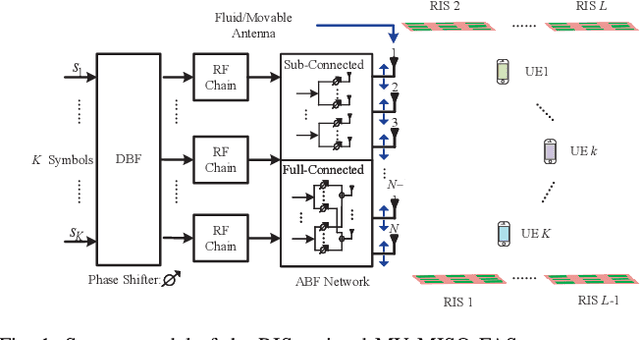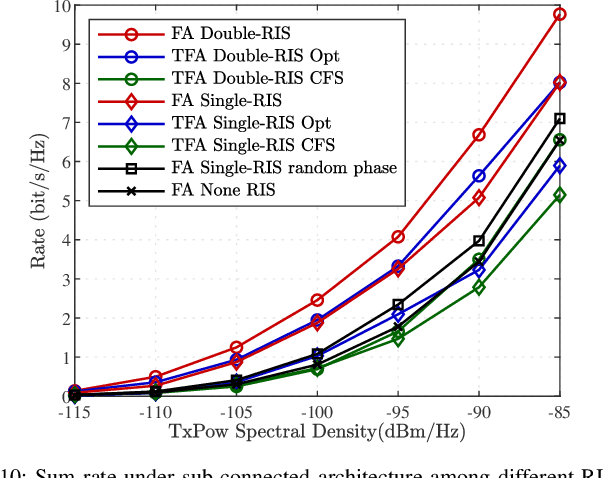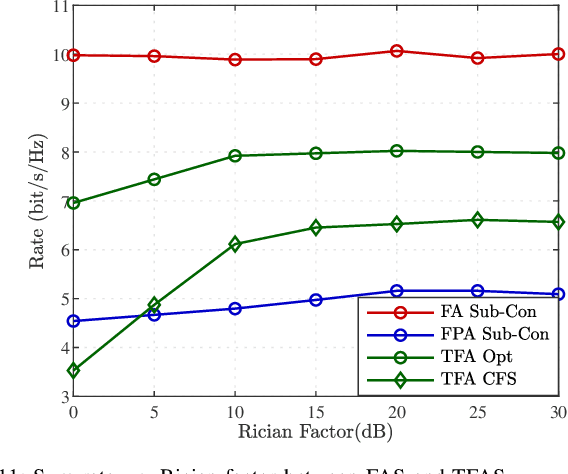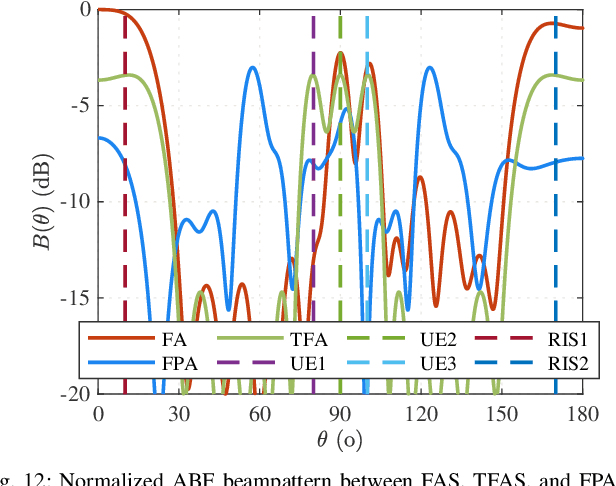Christos Masouros
Integrated Sensing and Communication with Tri-Hybrid Beamforming Across Electromagnetically Reconfigurable Antennas
Oct 16, 2025Abstract:Beamforming with a sufficient number of antennas is one of the most significant technologies for both Multi-user (MU) Multiple-input Multiple-output (MIMO) communication and MIMO radar sensing in Integrated Sensing and Communication (ISAC) systems. However, its performance suffers from limited Degrees of Freedom (DoFs) in conventional hybrid beamforming systems. To overcome this, we propose an Electromagnetically Reconfigurable Antenna (ERA)-aided ISAC system, where transmit ERAs dynamically adjust their radiation patterns to enhance system DoFs and improve overall performance. Specifically, we design a tri-hybrid beamforming optimization framework combining digital, analog, and Electromagnetic (EM) beamforming to jointly maximize communication rate and sensing Signal-to-Clutter-plus-Noise Ratio (SCNR). Furthermore, an integrated Fractional Programming (FP) and Manifold Optimization (MO) approach is developed to transform the problem into tractable subproblems with closed-form updates. Simulation results verify that the proposed ERA-ISAC system achieves almost 10 dB Sensing and Communication (S&C) performance gain compared to its conventional hybrid beamforming counterparts with Omnidirectional Antenna (OA).
Integrated Sensing and Communication: Towards Multifunctional Perceptive Network
Oct 16, 2025Abstract:The capacity-maximization design philosophy has driven the growth of wireless networks for decades. However, with the slowdown in recent data traffic demand, the mobile industry can no longer rely solely on communication services to sustain development. In response, Integrated Sensing and Communications (ISAC) has emerged as a transformative solution, embedding sensing capabilities into communication networks to enable multifunctional wireless systems. This paradigm shift expands the role of networks from sole data transmission to versatile platforms supporting diverse applications. In this review, we provide a bird's-eye view of ISAC for new researchers, highlighting key challenges, opportunities, and application scenarios to guide future exploration in this field.
Optical Computation-in-Communication enables low-latency, high-fidelity perception in telesurgery
Oct 15, 2025Abstract:Artificial intelligence (AI) holds significant promise for enhancing intraoperative perception and decision-making in telesurgery, where physical separation impairs sensory feedback and control. Despite advances in medical AI and surgical robotics, conventional electronic AI architectures remain fundamentally constrained by the compounded latency from serial processing of inference and communication. This limitation is especially critical in latency-sensitive procedures such as endovascular interventions, where delays over 200 ms can compromise real-time AI reliability and patient safety. Here, we introduce an Optical Computation-in-Communication (OCiC) framework that reduces end-to-end latency significantly by performing AI inference concurrently with optical communication. OCiC integrates Optical Remote Computing Units (ORCUs) directly into the optical communication pathway, with each ORCU experimentally achieving up to 69 tera-operations per second per channel through spectrally efficient two-dimensional photonic convolution. The system maintains ultrahigh inference fidelity within 0.1% of CPU/GPU baselines on classification and coronary angiography segmentation, while intrinsically mitigating cumulative error propagation, a longstanding barrier to deep optical network scalability. We validated the robustness of OCiC through outdoor dark fibre deployments, confirming consistent and stable performance across varying environmental conditions. When scaled globally, OCiC transforms long-haul fibre infrastructure into a distributed photonic AI fabric with exascale potential, enabling reliable, low-latency telesurgery across distances up to 10,000 km and opening a new optical frontier for distributed medical intelligence.
Sensing-Secure ISAC: Ambiguity Function Engineering for Impairing Unauthorized Sensing
Oct 02, 2025Abstract:The deployment of integrated sensing and communication (ISAC) brings along unprecedented vulnerabilities to authorized sensing, necessitating the development of secure solutions. Sensing parameters are embedded within the target-reflected signal leaked to unauthorized passive radar sensing eavesdroppers (Eve), implying that they can silently extract sensory information without prior knowledge of the information data. To overcome this limitation, we propose a sensing-secure ISAC framework that ensures secure target detection and estimation for the legitimate system, while obfuscating unauthorized sensing without requiring any prior knowledge of Eve. By introducing artificial imperfections into the ambiguity function (AF) of ISAC signals, we introduce artificial targets into Eve's range profile which increase its range estimation ambiguity. In contrast, the legitimate sensing receiver (Alice) can suppress these AF artifacts using mismatched filtering, albeit at the expense of signal-to-noise ratio (SNR) loss. Employing an OFDM signal, a structured subcarrier power allocation scheme is designed to shape the secure autocorrelation function (ACF), inserting periodic peaks to mislead Eve's range estimation and degrade target detection performance. To quantify the sensing security, we introduce peak sidelobe level (PSL) and integrated sidelobe level (ISL) as key performance metrics. Then, we analyze the three-way trade-offs between communication, legitimate sensing, and sensing security, highlighting the impact of the proposed sensing-secure ISAC signaling on system performance. We formulate a convex optimization problem to maximize ISAC performance while guaranteeing a certain sensing security level. Numerical results validate the effectiveness of the proposed sensing-secure ISAC signaling, demonstrating its ability to degrade Eve's target estimation while preserving Alice's performance.
A Novel Symbol Level Precoding based AFDM Transmission Framework: Offloading Equalization Burden to Transmitter Side
Aug 17, 2025Abstract:Affine Frequency Division Multiplexing (AFDM) has attracted considerable attention for its robustness to Doppler effects. However, its high receiver-side computational complexity remains a major barrier to practical deployment. To address this, we propose a novel symbol-level precoding (SLP)-based AFDM transmission framework, which shifts the signal processing burden in downlink communications from user side to the base station (BS), enabling direct symbol detection without requiring channel estimation or equalization at the receiver. Specifically, in the uplink phase, we propose a Sparse Bayesian Learning (SBL) based channel estimation algorithm by exploiting the inherent sparsity of affine frequency (AF) domain channels. In particular, the sparse prior is modeled via a hierarchical Laplace distribution, and parameters are iteratively updated using the Expectation-Maximization (EM) algorithm. We also derive the Bayesian Cramer-Rao Bound (BCRB) to characterize the theoretical performance limit. In the downlink phase, the BS employs the SLP technology to design the transmitted waveform based on the estimated uplink channel state information (CSI) and channel reciprocity. The resulting optimization problem is formulated as a second-order cone programming (SOCP) problem, and its dual problem is investigated by Lagrangian function and Karush-Kuhn-Tucker conditions. Simulation results demonstrate that the proposed SBL estimator outperforms traditional orthogonal matching pursuit (OMP) in accuracy and robustness to off-grid effects, while the SLP-based waveform design scheme achieves performance comparable to conventional AFDM receivers while significantly reducing the computational complexity at receiver, validating the practicality of our approach.
Faster-than-Nyquist Signaling is Good for Single-Carrier ISAC: An Analytical Study
Jun 11, 2025Abstract:In this paper, we provide an analytical study of single-carrier faster-than-Nyquist (FTN) signaling for integrated sensing and communications (ISAC). Our derivations show that FTN is advantageous for ISAC, and reveal new insights that these advantages come from the fact that FTN signaling can effectively avoid the spectral aliasing due to the mismatch between the symbol rate and the bandwidth of the shaping pulse. Specifically, the communication spectral efficiency advantages of FTN signaling over time-invariant multipath channels are analytically shown, where both upper- and lower-bounds on the spectral efficiency are derived. We show that the gap between these two bounds corresponds to the potential signal-to-noise ratio (SNR) variation due to the presence of multipath delay and spectral aliasing, which diminishes as the symbol rate grows higher. Particularly, in the limiting case, this SNR variation disappears while the degree of freedom (DoF) of the system attain the maximum. Furthermore, the sensing advantages for FTN signals are verified in terms of the expected normalized squared ambiguity function. We show that FTN signals generally enjoy a more robust ranging performance. More importantly, we prove that FTN signaling can effectively avoid the undesired peaks in the considered ambiguity function along the Doppler dimension, thereby reducing the ambiguities in velocity estimation. All these conclusions are explicitly verified by numerical results.
Pilot-Based End-to-End Radio Positioning and Mapping for ISAC: Beyond Point-Based Landmarks
May 12, 2025



Abstract:Integrated sensing and communication enables simultaneous communication and sensing tasks, including precise radio positioning and mapping, essential for future 6G networks. Current methods typically model environmental landmarks as isolated incidence points or small reflection areas, lacking detailed attributes essential for advanced environmental interpretation. This paper addresses these limitations by developing an end-to-end cooperative uplink framework involving multiple base stations and users. Our method uniquely estimates extended landmark objects and incorporates obstruction-based outlier removal to mitigate multi-bounce signal effects. Validation using realistic ray-tracing data demonstrates substantial improvements in the richness of the estimated environmental map.
Dynamic Precoding for Near-Field Secure Communications: Implementation and Performance Analysis
May 08, 2025Abstract:The increase in antenna apertures and transmission frequencies in next-generation wireless networks is catalyzing advancements in near-field communications (NFC). In this paper, we investigate secure transmission in near-field multi-user multiple-input single-output (MU-MISO) scenarios. Specifically, with the advent of extremely large-scale antenna arrays (ELAA) applied in the NFC regime, the spatial degrees of freedom in the channel matrix are significantly enhanced. This creates an expanded null space that can be exploited for designing secure communication schemes. Motivated by this observation, we propose a near-field dynamic hybrid beamforming architecture incorporating artificial noise, which effectively disrupts eavesdroppers at any undesired positions, even in the absence of their channel state information (CSI). Furthermore, we comprehensively analyze the dynamic precoder's performance in terms of the average signal-to-interference-plus-noise ratio, achievable rate, secrecy capacity, secrecy outage probability, and the size of the secrecy zone. In contrast to far-field secure transmission techniques that only enhance security in the angular dimension, the proposed algorithm exploits the unique properties of spherical wave characteristics in NFC to achieve secure transmission in both the angular and distance dimensions. Remarkably, the proposed algorithm is applicable to arbitrary modulation types and array configurations. Numerical results demonstrate that the proposed method achieves approximately 20\% higher rate capacity compared to zero-forcing and the weighted minimum mean squared error precoders.
Network-Level ISAC Design: State-of-the-Art, Challenges, and Opportunities
May 02, 2025



Abstract:The ultimate goal of integrated sensing and communication (ISAC) deployment is to provide coordinated sensing and communication services at an unprecedented scale. This paper presents a comprehensive overview of network-level ISAC systems, an emerging paradigm that significantly extends the capabilities of link-level ISAC through distributed cooperation. We first examine recent advancements in network-level ISAC architectures, emphasizing various cooperation schemes and distributed system designs. The sensing and communication (S\&C) performance is analyzed with respect to interference management and cooperative S\&C, offering new insights into the design principles necessary for large-scale networked ISAC deployments. In addition, distributed signaling strategies across different levels of cooperation are reviewed, focusing on key performance metrics such as sensing accuracy and communication quality-of-service (QoS). Next, we explore the key challenges for practical deployment where the critical role of synchronization is also discussed, highlighting advanced over-the-air synchronization techniques specifically tailored for bi-static and distributed ISAC systems. Finally, open challenges and future research directions in network-level ISAC design are identified. The findings and discussions aim to serve as a foundational guideline for advancing scalable, high-performance, and resilient distributed ISAC systems in next-generation wireless networks.
Hybrid Beamforming for RIS-Assisted Multiuser Fluid Antenna Systems
Apr 12, 2025



Abstract:Recent advances in reconfigurable antennas have led to the new concept of the fluid antenna system (FAS) for shape and position flexibility, as another degree of freedom for wireless communication enhancement. This paper explores the integration of a transmit FAS array for hybrid beamforming (HBF) into a reconfigurable intelligent surface (RIS)-assisted communication architecture for multiuser communications in the downlink, corresponding to the downlink RIS-assisted multiuser multiple-input single-output (MISO) FAS model (Tx RIS-assisted-MISO-FAS). By considering Rician channel fading, we formulate a sum-rate maximization optimization problem to alternately optimize the HBF matrix, the RIS phase-shift matrix, and the FAS position. Due to the strong coupling of multiple optimization variables, the multi-fractional summation in the sum-rate expression, the modulus-1 limitation of analog phase shifters and RIS, and the antenna position variables appearing in the exponent, this problem is highly non-convex, which is addressed through the block coordinate descent (BCD) framework in conjunction with semidefinite relaxation (SDR) and majorization-minimization (MM) methods. To reduce the computational complexity, we then propose a low-complexity grating-lobe (GL)-based telescopic-FAS (TFA) with multiple delicately deployed RISs under the sub-connected HBF architecture and the line-of-sight (LoS)-dominant channel condition, to allow closed-form solutions for the HBF and TFA position. Our simulation results illustrate that the former optimization scheme significantly enhances the achievable rate of the proposed system, while the GL-based TFA scheme also provides a considerable gain over conventional fixed-position antenna (FPA) systems, requiring statistical channel state information (CSI) only and with low computational complexity.
 Add to Chrome
Add to Chrome Add to Firefox
Add to Firefox Add to Edge
Add to Edge